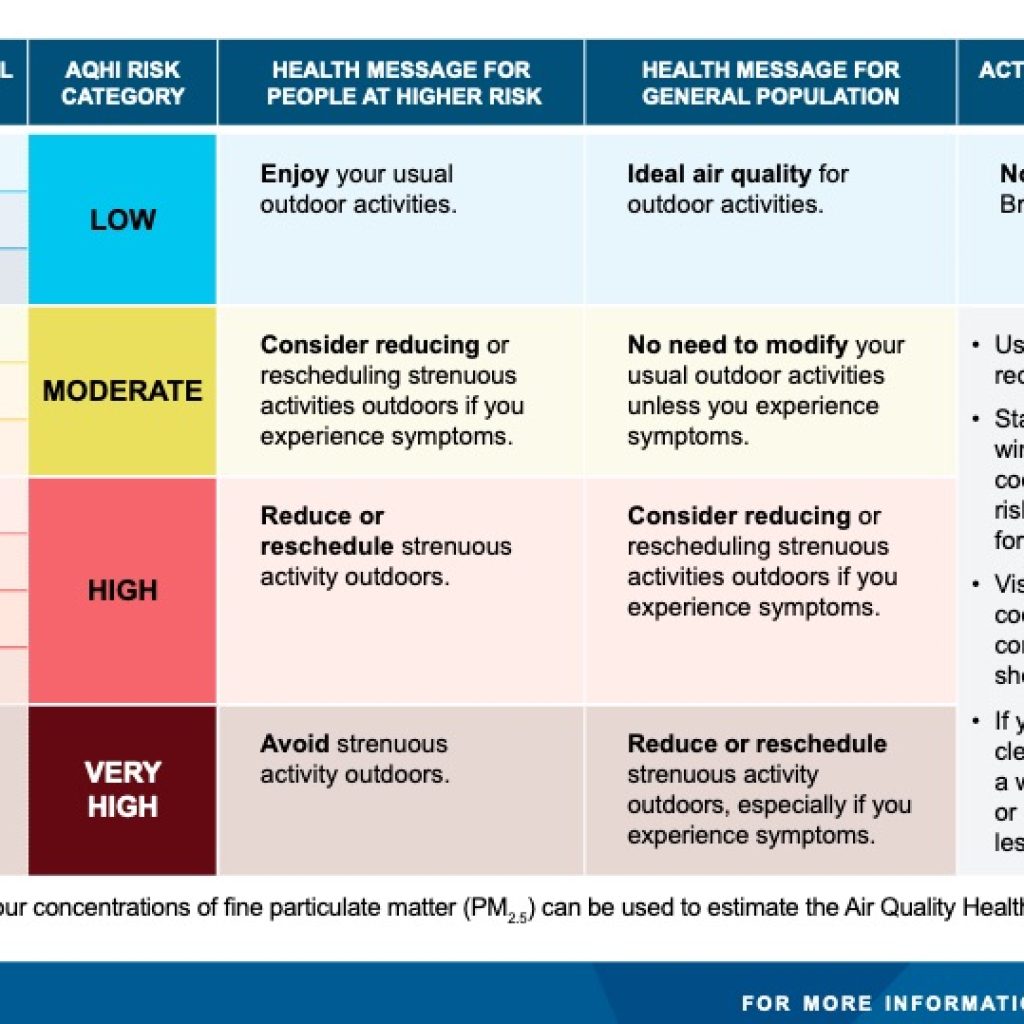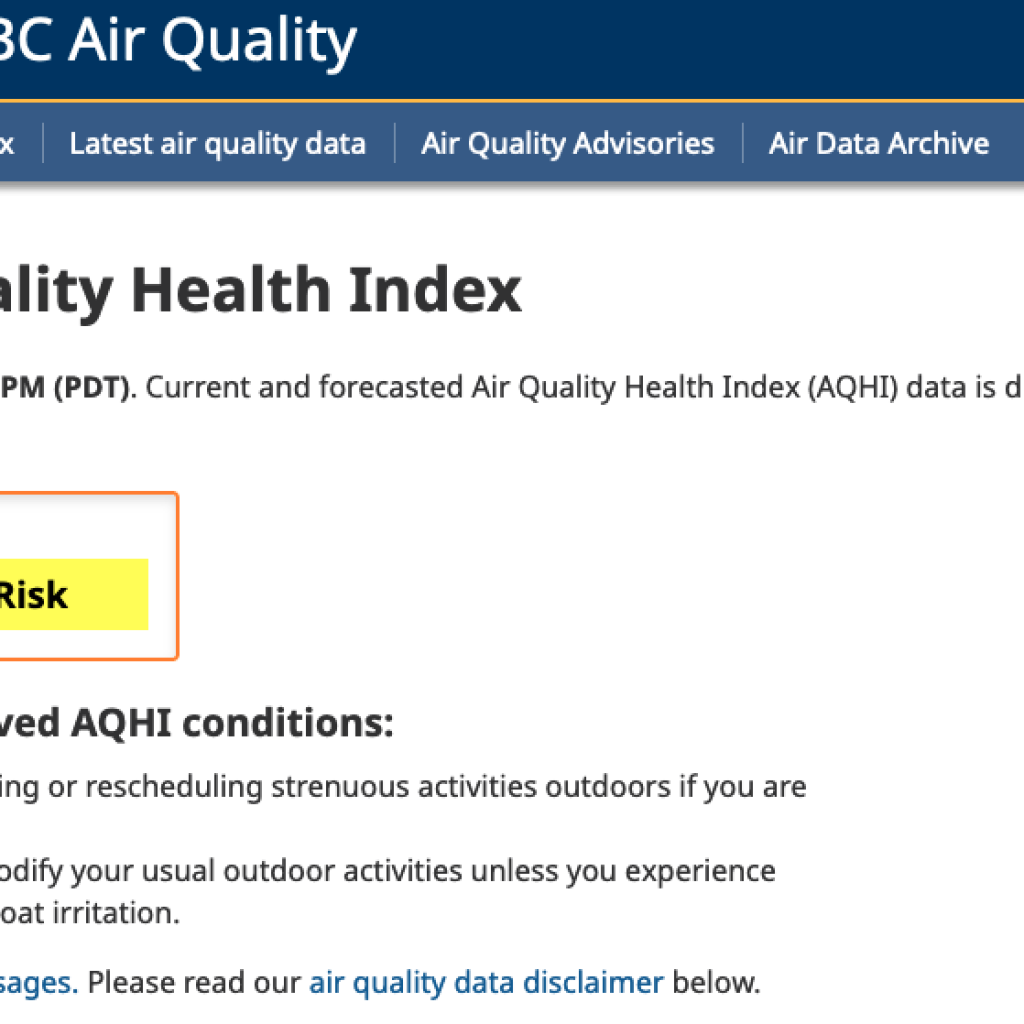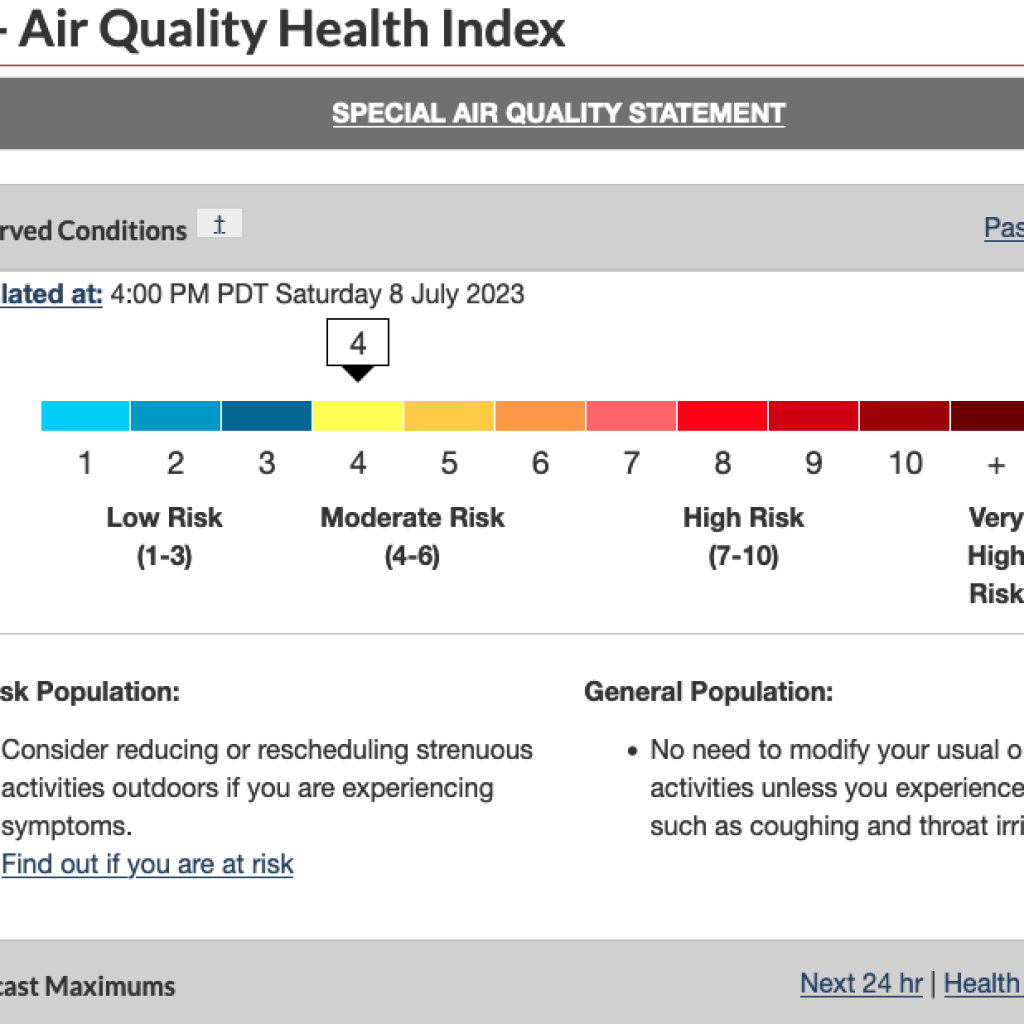For more on health and safety, subscription or notification services and apps click here.
From the BC Centre for Disease Control:
Different agencies provide information on current air quality across the
province using a range of tools. Wildfire smoke, like wood burning appliances is a complex mixture of air pollutants, but fine particulate matter (PM2.5 ) poses the greatest risk to human health.
In British Columbia, the current PM 2.5 levels can be used to estimate the current Air Quality Health Index (AQHI), which provides health advice for different risk categories of people. If your community does not have an AQHI listed then this chart gives you an idea of health risk according to sensor readings near you. Click the image to get to BCCDC’s factsheet.

Charts like these exist on most maps where smoke levels are recorded.
For more about how smoke is measured and these levels are figured out click here: plain language on micro emissions.
The Air Quality Health Index (AQHI) provides hourly air quality readings and related health messages. The AQHI reports on the health risks posed by a mixture of pollutants, including:
- Particulate matter (PM2.5)
- Ground-level ozone (O3)
- Nitrogen dioxide (NO2)
British Columbians can use the AQHI to check the quality of outdoor air before heading off to work or play.

The federal government also produces an AQHI and it looks like this:

Short Term Impacts:
Spikes in Levels of PM2.5 or PM10 can be dangerous to your health. Short Term levels to worry about are those that last 1 hour to 24 hours. A 10 minute spike is common when people light up stoves. Don’t worry!
What to do if you notice spikes or high levels at the sensor…
- Move indoors, walk in the direction where air is clear, reschedule or cancel outdoor events, go on a sleep over.
- Close your windows and doors. Run HEPA or other home air filters. Some people are known to put foam in their windows to filter the air but we can help you build cheap home air filters. We can provide you a square filter for a box fan and this will filter tiny particles including particulate, pollen and animal dander.
- Use other forms of heat. Try using a heat pump or go electric when readings are high, using a wood heating appliance will only add to the problem.
- Refrain from adding other emissions to the air! Wait on that campfire, recycle- don’t burn grass or garbage, upgrade your wood burning appliance, try an experiment with chipping and mulching rather than burning that woody debris.
Long Term Impacts:
Air pollution affects human health. The World Health Organization estimates that air pollution causes approximately 2 million premature deaths worldwide each year. More locally, the Canadian Medical Association (CMA) estimated that for British Columbia in 2008, air pollution would result in 306 acute premature deaths, 1,158 hospital admissions, 8,763 emergency department visits, 62,112 doctor’s office visits and 2,526,900 minor illnesses. The economic loss through lost productivity, healthcare costs, pain and suffering and loss of life was estimated to be over 900 million dollars. As noted in Chapter 1, the most significant air pollutant in the BVLD is fine particulate matter, PM2.5. A study conducted by Elliot and Copes (2011) has estimated that between 16 to 74 deaths each year are attributable to fine particulate matter concentrations in Northern and Interior Health Regions alone.
What health professionals are beginning to understand is that the entire population, including healthy young individuals, will experience some physiological effects from air pollution. Although these may go unnoticed by the individual, they can lead to more serious and chronic illnesses over time. In other words, one death resulting from air quality represents a much larger burden of illness.
The Health Effects of Particulate Matter, Source: BVLD Airshed Management Plan, June 2012
• Exposure to particulate matter can have both immediate and long-term health effects. Short term exposure to relatively high concentrations of PM, such as those experienced during episode or air quality advisory days, can trigger breathing problems, increase the severity and occurrences of asthma attacks, trigger heart attacks, cause eye, nose and throat irritation and result in acute premature deaths. These symptoms will generally be experienced by a subset of the population identified as sensitive individuals: the elderly, children, pregnant women and those with pre-existing respiratory and cardiovascular conditions.
• Long-term exposure to PM, even at relatively low levels, can put the entire population at an increased risk of developing heart and lung diseases, including chronic bronchitis, emphysema, pneumonia and lung cancer. Long-term exposure to fine particulate matter has also been linked to pre-term births, low birth weight babies, acute respiratory infections and middle ear infections in children.
• While much of the media attention and public pressure is around short-term episodes (e.g. air quality advisories days), the majority of health impacts appear to be the result from chronic exposure over many years. For instance, the CMA report cited above found that 87% of the estimated air pollution-related deaths in 2008 were due to chronic exposure. This is important to keep in mind when developing management strategies for addressing air quality issues within an airshed.
